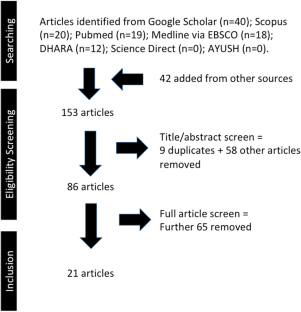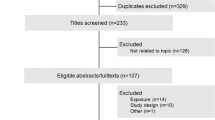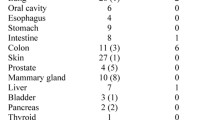Abstract
Herbal teas are used as therapeutic vehicles in many forms of traditional medicine and are a popular global beverage. The purpose of this scoping review was to examine the evidence relating to the clinical efficacy and safety of herbal teas, and to identify the main research themes and gaps in knowledge to inform further work. A scoping review methodology was followed that set out the research question and described the sourcing, selection and analysis of studies. Overall, a total of 145 research publications were retrieved from global bibliographic databases, and after applying exclusion criteria, 21 remained. These studies looked at herbal tea use in female health, diabetes, heart disease and weight loss, with plant species including lavender, chamomile, fenugreek, stinging nettle, spearmint, hibiscus, yerba maté, echinacea and combinations of herbs. Observational studies explored associations between herbal tea consumption and cancer risk, liver health, and the risks linked to the consumption of environmental contaminants in the plant material. Despite plant materials being the basis for drug discovery, and the popularity of herbal teas, the number of articles exploring clinical efficacy and safety is small. In this review we discuss how herbal teas may be beneficial in some areas of clinical and preventative health, and what further research is required to understand whether regular consumption can contribute to healthy living more generally.


Similar content being viewed by others
References
World Health Organisation (2012) The top 10 causes of death. World Health Organisation. http://www.who.int/mediacentre/factsheets/fs310/en/. Accessed 11 June 2019
Calder PC, Carding SR, Christopher G, Kuh D, Langley-Evans SC, McNulty H (2018) A holistic approach to healthy ageing: how can people live longer, healthier lives? J Hum Nutr Diet 31:439–450. https://doi.org/10.1111/jhn.12566
Schulze MB, Martínez-González MA, Fung TT, Lichtenstein AH, Forouhi NG (2018) Food based dietary patterns and chronic disease prevention. BMJ 361:k2396. https://doi.org/10.1136/bmj.k2396
Lachat C, Raneri JE, Smith KW, Kolsteren P, Van Damme P, Verzelen K, Penafiel D, Vanhove W, Kennedy G, Hunter D, Odhiambo FO (2018) Dietary species richness as a measure of food biodiversity and nutritional quality of diets. Proc Natl Acad Sci 115:127–132. https://doi.org/10.1073/pnas.1709194115
Kromhout D, Spaaij CJK, De Goede J, Weggemans RM (2015) The 2015 Dutch food-based dietary guidelines. Eur J Clin Nutr 70:869–878. https://doi.org/10.1038/ejcn.2016.52
Khan N, Mukhtar H (2013) Tea and health: studies in humans. Curr Pharm Des 19:6141–6147. https://doi.org/10.2174/1381612811319340008
Suzuki Y, Miyoshi N, Isemura M (2012) Health-promoting effects of green tea. Proc Jpn Acad Ser B 88:88–101. https://doi.org/10.2183/pjab.88.88
Yang YC, Lu FH, Wu JS, Wu CH, Chang CJ (2004) The protective effect of habitual tea consumption on hypertension. Arch Intern Med 164:1534–1540. https://doi.org/10.1001/archinte.164.14.1534
Tandon N, Yadav SS (2017) Contributions of Indian Council of Medical Research (ICMR) in the area of medicinal plants/traditional medicine. Ethnopharmacol 197:39–45. https://doi.org/10.1016/j.jep.2016.07.064
Ritch-Krc EM, Thomas S, Turner NJ, Towers GHN (1996) Carrier herbal medicine: traditional and contemporary plant use. J Ethnopharmacol 52:85–94. https://doi.org/10.1016/0378-8741(96)01392-X
McKay DL, Blumberg JB (2006) A review of the bioactivity and potential health benefits of peppermint tea (Mentha piperita L.). Phytother Res 20:619–633. https://doi.org/10.1002/ptr.1936
McKay DL, Blumberg JB (2006) A review of the bioactivity and potential health benefits of chamomile tea (Matricaria recutita L.). Phytother Res 20:519–530. https://doi.org/10.1002/ptr.1900
World Health Organisation (2013) WHO traditional medicine strategy 2014–2023. World Health Organization. https://www.who.int/medicines/publications/traditional/trm_strategy14_23/en/. Accessed 11 June 2019
Zhang AL, Xue CC, Fong HHS (2011) Integration of herbal medicine into evidence-based clinical practice. In: Benzie IFF, Wachtel-Galor S (eds) Herbal Medicine: biomolecular and clinical aspects, 2nd edn. CRC Press, Taylor Francis
Das S, de Oliveira LM, da Silva E, Liu Y, Ma LQ (2017) Fluoride concentrations in traditional and herbal teas: health risk assessment. Environ Pollut 231:779–784. https://doi.org/10.1016/j.envpol.2017.08.083
Black C, Haughey SA, Chevallier OP, Galvin-King P, Elliott CT (2016) A comprehensive strategy to detect the fraudulent adulteration of herbs: the oregano approach. Food Chem 210:551–557. https://doi.org/10.1016/j.foodchem.2016.05.004
Cacchione PZ (2016) The evolving methodology of scoping reviews. Clin Nurs Res 25(2):115–119. https://doi.org/10.1177/1054773816637493
Tricco AC, Lillie E, Zarin W, O’Brien K, Colquhoun H, Kastner M, Levac D, Ng C, Sharpe JP, Wilson K, Kenny M (2016) A scoping review on the conduct and reporting of scoping reviews. BMC Med Res Methodol 16(1):15. https://doi.org/10.1186/s12874-016-0116-4
Moher D, Liberati A, Tetzlaff J, Altman DG (2009) Preferred reporting items for systematic reviews and meta-analyses: the PRISMA statement. Ann Intern Med 151:264–269. https://doi.org/10.1371/journal.pmed.1000097
Narahari SR, Aggithaya MG, Suraj KR (2010) A protocol for systematic reviews of Ayurveda treatments. Int J Ayurveda Res 1:254–267. https://doi.org/10.4103/0974-7788.76791
World Health Organisation (2018) Constitution of WHO: principles. World Health Organisation. https://www.who.int/about/mission/en/. Accessed 11 June 2019
Vidya TJ, Kulkarni KS (2002) Using herbal tea in the treatment modality: special reference to slimtea in overweight individuals. Anc Sci Life 21(3):202–204
Jayawardena MHS, De Alwis NMW, Hettigoda V, Fernando DJS (2005) A double blind randomised placebo controlled cross over study of a herbal preparation containing Salacia reticulata in the treatment of type 2 diabetes. J Ethnopharmacol 97(2):215–218. https://doi.org/10.1016/j.jep.2004.10.026
McKay DL, Chen CYO, Saltzman E, Blumberg JB (2009) Hibiscus sabdariffa L. tea (tisane) lowers blood pressure in prehypertensive and mildly hypertensive adults. J Nutr 140(2):298–303. https://doi.org/10.3945/jn.109.115097
Mozaffari-Khosravi H, Jalali-Khanabadi BA, Afkhami-Ardekani M, Fatehi F, Noori-Shadkam M (2009) The effects of sour tea (Hibiscus sabdariffa) on hypertension in patients with type II diabetes. J Hum Hypertens 23(1):48–54. https://doi.org/10.1038/jhh.2008.100
Ryan EA, Imes S, Wallace C, Jones S (2000) Herbal tea in the treatment of diabetes mellitus. Clin Investig Med 23(5):311–317
Zemestani M, Rafraf M, Asghari-Jafarabadi M (2016) Chamomile tea improves glycemic indices and antioxidants status in patients with type 2 diabetes mellitus. Nutrition 32(1):66–72. https://doi.org/10.1016/j.nut.2015.07.011
Grant P (2010) Spearmint herbal tea has significant anti-androgen effects in polycystic ovarian syndrome. A randomized controlled trial. Phytother Res 24(2):186–188. https://doi.org/10.1002/ptr.2900
Akdoğan M, Tamer MN, Cüre E, Cüre MC, Köroğlu BK, Delibaş N (2007) Effect of spearmint (Mentha spicata Labiatae) teas on androgen levels in women with hirsutism. Phytother Res 21(5):444–447. https://doi.org/10.1002/ptr.2074
Chen S, Chen C (2015) Effects of lavender tea on fatigue, depression, and maternal-infant attachment in sleep-disturbed postnatal women. Worldviews Evid Based Nurs 12(6):370–379. https://doi.org/10.1111/wvn.12122
Chang S, Chen C (2016) Effects of an intervention with drinking chamomile tea on sleep quality and depression in sleep disturbed postnatal women: a randomized controlled trial. J Adv Nurs 72(2):306–315. https://doi.org/10.1111/jan.12836
Ozalkaya E, Aslandoğdu Z, Özkoral A, Topcuoğlu S, Karatekin G (2018) Effect of a galactagogue herbal tea on breast milk production and prolactin secretion by mothers of preterm babies. Niger J Clin Pract 21(1):38–42. https://doi.org/10.4103/1119-3077.224788
Turkyılmaz C, Onal E, Hirfanoglu IM, Turan O, Koç E, Ergenekon E, Atalay Y (2011) The effect of galactagogue herbal tea on breast milk production and short-term catch-up of birth weight in the first week of life. J Altern Complement Med 17(2):139–142. https://doi.org/10.1089/acm.2010.0090
Kavurt S, Bas AY, Aydemir O, Yucel H, Isıkoglu S, Demirel N (2013) The effect of galactagogue herbal tea on oxidant and anti-oxidant status of human milk. J Matern Fetal Neonatal Med 26(10):1048–1051. https://doi.org/10.3109/14767058.2013.766690
Denzer MY, Kirsch F, Buettner A (2014) Are odorant constituents of herbal tea transferred into human milk? J Agric Food Chem 63(1):104–111. https://doi.org/10.1021/jf504073d
Maufrais C, Sarafian D, Dulloo A, Montani JP (2018) Cardiovascular and metabolic responses to the ingestion of caffeinated herbal tea: drink it hot or cold? Front Physiol 9:315. https://doi.org/10.3389/fphys.2018.00315
Lindenmuth GF, Lindenmuth EB (2000) The efficacy of echinacea compound herbal tea preparation on the severity and duration of upper respiratory and flu symptoms: a randomized, double-blind placebo-controlled study. J Altern Complement Med 6(4):327–334. https://doi.org/10.1089/10755530050120691
Chio PH, Zaroff CM (2015) Traditional Chinese medicinal herbal tea consumption, self-reported somatization, and alexithymia. Asia Pac Psychiatry 7(2):127–134. https://doi.org/10.1111/appy.12161
Riza E, Linos A, Petralias A, de Martinis L, Duntas L, Linos D (2015) The effect of Greek herbal tea consumption on thyroid cancer: a case-control study. Euro J Public Health 25(6):1001–1005. https://doi.org/10.1093/eurpub/ckv063
Colapinto CK, Arbuckle TE, Dubois L, Fraser W (2016) Is there a relationship between tea intake and maternal whole blood heavy metal concentrations? J Expo Sci Environ Epidemiol 26(5):503–509. https://doi.org/10.1038/jes.2015.86
Colapinto CK, Arbuckle TE, Dubois L, Fraser W (2015) Tea consumption in pregnancy as a predictor of pesticide exposure and adverse birth outcomes: the MIREC study. Environ Res 142:77–83. https://doi.org/10.1016/j.envres.2015.06.020
Alferink LJ, Fittipaldi J, Kiefte-de Jong JC, Taimr P, Hansen BE, Metselaar HJ, Schoufour JD, Ikram MA, Janssen HL, Franco OH, Murad SD (2017) Coffee and herbal tea consumption is associated with lower liver stiffness in the general population: the Rotterdam study. J Hepatol 67(2):339–348. https://doi.org/10.1016/j.jhep.2017.03.013
Gertsch J (2016) The metabolic plant feedback hypothesis: how plant secondary metabolites nonspecifically impact human health. Planta Med 82(11–12):920–929. https://doi.org/10.1055/s-0042-108340
Foti MC (2007) Antioxidant properties of phenols. J Pharm Pharmacol 59(12):1673–1685. https://doi.org/10.1211/jpp.59.12.0010
Pengelly A (2004) The constituents of medicinal plants: an introduction to the chemistry and therapeutics of herbal medicine. CABI Publishing
Booker A, Frommenwiler D, Johnston D, Umealajekwu C, Reich E, Heinrich M (2014) Chemical variability along the value chains of turmeric (Curcuma longa): a comparison of nuclear magnetic resonance spectroscopy and high performance thin layer chromatography. J Ethnopharmacol 152(2):292–301. https://doi.org/10.1016/j.jep.2013.12.042
Periche A, Koutsidis G, Escriche I (2014) Composition of antioxidants and amino acids in Stevia leaf infusions. Plant Foods Hum Nutr 69(1):1–7. https://doi.org/10.1007/s11130-013-0398-1
Moss M, Oliver L (2012) Plasma 1, 8-cineole correlates with cognitive performance following exposure to rosemary essential oil aroma. Ther Adv Psychopharmacol 2(3):103–113. https://doi.org/10.1177/2045125312436573
Horžić D, Komes D, Belščak A, Ganić KK, Iveković D, Karlović D (2009) The composition of polyphenols and methylxanthines in teas and herbal infusions. Food Chem 115(2):441–448. https://doi.org/10.1016/j.foodchem.2008.12.022
Bhebhe M, Chipurura B, Muchuweti M (2015) Determination and comparison of phenolic compound content and antioxidant activity of selected local Zimbabwean herbal teas with exotic Aspalathus linearis. S Afr J Bot 100:213–218. https://doi.org/10.1016/j.sajb.2015.06.006
Guimarães R, Barros L, Carvalho AM, Ferreira IC (2011) Infusions and decoctions of mixed herbs used in folk medicine: synergism in antioxidant potential. Phytother Res 25(8):1209–1214. https://doi.org/10.1002/ptr.3366
Yin SY, Wei WC, Jian FY, Yang NS (2013) Therapeutic applications of herbal medicines for cancer patients. Evid-Based Complement Alternat Med. https://doi.org/10.1155/2013/302426
Yin SY, Yang NS, Lin TJ (2017) Phytochemicals approach for developing cancer immune-therapeutics. Front Pharmacol 8:386. https://doi.org/10.3389/fphar.2017.00386
Tschiggerl C, Bucar F (2012) Guaianolides and volatile compounds in chamomile tea. Plant Foods Hum Nutr 67(2):129–135. https://doi.org/10.1007/s11130-012-0277-1
Singh O, Khanam Z, Misra N, Srivastava MK (2011) Chamomile (Matricaria chamomilla L.): an overview. Pharmacogn Rev 5:82–95. https://doi.org/10.4103/0973-7847.79103
Seow YX, Yeo CR, Chung HL, Yuk HG (2014) Plant essential oils as active antimicrobial agents. Crit Rev Food Sci Nutr 54(5):625–644. https://doi.org/10.1080/10408398.2011.599504
Abdul Qadir M, Shahzadi SK, Bashir A, Munir A, Shahzad S (2017) Evaluation of phenolic compounds and antioxidant and antimicrobial activities of some common herbs. Int J Anal Chem. https://doi.org/10.1155/2017/3475738
Schoop R, Klein P, Suter A, Johnston SL (2006) Echinacea in the prevention of induced rhinovirus colds: a meta-analysis. Clin Ther 28(2):174–183. https://doi.org/10.1016/j.clinthera.2006.02.001
Schapowal A, Klein P, Johnston SL (2015) Echinacea reduces the risk of recurrent respiratory tract infections and complications: a meta-analysis of randomized controlled trials. Adv Ther 32(3):187–200. https://doi.org/10.1007/s12325-015-0194-4
Denner SS (2009) Lavandula angustifolia Miller: english lavender. Holist Nurs Pract 23(1):57–64. https://doi.org/10.1097/01.HNP.0000343210.56710.fc
Burns EE, Blamey C, Ersser SJ, Barnetson L, Lloyd AJ (2000) An investigation into the use of aromatherapy in intrapartum midwifery practice. J Altern Complement Med 6(2):141–147. https://doi.org/10.1089/acm.2000.6.141
Koulivand PH, Khaleghi Ghadiri M, Gorji A (2013) Lavender and the nervous system. Evid Based Complement Alternat Med 2013:1–10. https://doi.org/10.1155/2013/681304
Chrubasik JE, Roufogalis BD, Wagner H, Chrubasik S (2007) A comprehensive review on the stinging nettle effect and efficacy profiles. Part II: Urticae radix. Phytomedicine 14(7–8):568–579. https://doi.org/10.1016/j.phymed.2007.03.014
Wani SA, Kumar P (2018) Fenugreek: a review on its nutraceutical properties and utilization in various food products. J Saudi Soc Agric Sci 17(2):97–106. https://doi.org/10.1016/j.jssas.2016.01.007
Shawahna R, Qiblawi S, Ghanayem H (2018) Which benefits and harms of using fenugreek as a galactagogue need to be discussed during clinical consultations? A Delphi study among breastfeeding women, gynecologists, pediatricians, family physicians, lactation consultants, and pharmacists. Evid-Based Complementary Altern Med vol 2018, article ID 2418673. https://doi.org/10.1155/2018/2418673
Grant P, Ramasamy S (2012) An update on plant derived anti-androgens. Int J Endocrinol Metab 10(2):497–502. https://doi.org/10.5812/ijem.3644
Medagama AB (2015) Salacia reticulata (Kothala himbutu) revisited; a missed opportunity to treat diabetes and obesity? Nutr J 14:21. https://doi.org/10.1186/s12937-015-0013-4
Büyükbalci A, El SN (2008) Determination of in vitro antidiabetic effects, antioxidant activities and phenol contents of some herbal teas. Plant Foods Hum Nutr 63(1):27–33. https://doi.org/10.1007/s11130-007-0065-5
García-Conesa MT, Chambers K, Combet E, Pinto P, Garcia-Aloy M, Andrés-Lacueva C, de Pascual-Teresa S, Mena P, Konic Ristic A, Hollands W, Kroon P (2018) Meta-analysis of the effects of foods and derived products containing ellagitannins and anthocyanins on cardiometabolic biomarkers: analysis of factors influencing variability of the individual responses. Int J Mol Sci 19(3):E694. https://doi.org/10.3390/ijms19030694
Reis JF, Monteiro VVS, Gomes RS, Carmo MM, Costa GV, Ribera PC, Monteiro MC (2016) Action mechanism and cardiovascular effect of anthocyanins: a systematic review of animal and human studies. J Transl Med 14(1):315. https://doi.org/10.1186/s12967-016-1076-5
Daily JW, Yang M, Park S (2016) Efficacy of turmeric extracts and curcumin for alleviating the symptoms of joint arthritis: a systematic review and meta-analysis of randomized clinical trials. J Med Food 19(8):717–729. https://doi.org/10.1089/jmf.2016.3705
Kongkeaw C, Dilokthornsakul P, Thanarangsarit P, Limpeanchob N, Scholfield CN (2014) Meta-analysis of randomized controlled trials on cognitive effects of Bacopa monnieri extract. J Ethnopharmacol 151(1):528–535. https://doi.org/10.1016/j.jep.2013.11.008
Paredes-López O, Cervantes-Ceja ML, Vigna-Pérez M, Hernández-Pérez T (2010) Berries: improving human health and healthy aging, and promoting quality life—a review. Plant Foods Hum Nutr 65(3):299–308. https://doi.org/10.1007/s11130-010-0177-1
Makanjuola SA, Enujiugha VN (2017) Enhancing sensory perception of plant based nutraceutical drinks by combining plants from different sources: a preliminary study of tea and ginger blend. Prev Nutr Food Sci 22(4):372–375. https://doi.org/10.3746/pnf.2017.22.4.372
Son HU, Lee S, Heo JC, Lee SH (2017) The solid-state fermentation of Artemisia capillaris leaves with Ganoderma lucidum enhances the anti-inflammatory effects in a model of atopic dermatitis. Int J Mol Med 39(5):1233–1241. https://doi.org/10.3892/ijmm.2017.2945
Sheih IC, Fang TJ, Wu TK, Chang CH, Chen RY (2011) Purification and properties of a novel phenolic antioxidant from Radix astragali fermented by Aspergillus oryzae M29. J Agric Food Chem 59(12):6520–6525. https://doi.org/10.1021/jf2011547
Rolfe V (2018) Herbal tea safety and efficacy review. Figshare Dataset. https://doi.org/10.6084/m9.figshare.7398593.v1
Acknowledgements
This research was co-funded between the University of the West of England Internship Scheme and Pukka Herbs.
Author information
Authors and Affiliations
Corresponding author
Ethics declarations
Conflict of Interest
Pukka Herbs is a manufacturer of herbal teas and supplements. The data relating to this research is shared openly for transparency.
Additional information
Publisher’s Note
Springer Nature remains neutral with regard to jurisdictional claims in published maps and institutional affiliations.
Rights and permissions
About this article
Cite this article
Poswal, F.S., Russell, G., Mackonochie, M. et al. Herbal Teas and their Health Benefits: A Scoping Review. Plant Foods Hum Nutr 74, 266–276 (2019). https://doi.org/10.1007/s11130-019-00750-w
Published:
Issue Date:
DOI: https://doi.org/10.1007/s11130-019-00750-w




